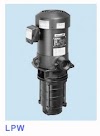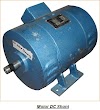Introduction To Engine Cycles
Otto and Diesel are the two principal cycles currently employed in internal combustion engines, named after the two men who are credited with their creation. The Otto cycle is also known as a constant volume or spark ignition cycle, while the Diesel cycle is known as a constant pressure or compression ignition cycle. These cycles can be set up as either a two-stroke or four-stroke cycle, with the piston producing power on every downward stroke.
Otto Cycle
The four-stroke Otto cycle has the following operations, as depicted in figure below:
 |
| Four-stroke spark ignition cycle. |
- An intake stroke in which a combustible mixture of fuel and air is drawn into the cylinder through the throttle and intake valve.
- The temperature of the mixture is raised by a compression stroke with the valves closed. At the end of the compression stroke, a spark ignites the mixture.
- The combustion of the fuel-air mixture results in an expansion or power stroke.
- The combustion of the fuel-air mixture results in an expansion or power stroke.
The intake manifold, a series of channels that equally distribute the air mixture to perorangan cylinders, allows air to enter the engine. The fuel is combined with the inflow air using a fuel injector or carburetor in the intake manifold, intake port, or directly injected into the cylinder, resulting in a homogeneous mixture filling the cylinder. When a spark ignites the mixture, a turbulent flame forms and spreads through it, raising the cylinder's temperature and pressure. When the flame reaches the cylinder walls, it goes out. The compressed gases ahead of the flame will autoignite if the starting pressure is too high, generating an issue known as knock. The maximum compression ratio and hence the efficiency of Otto cycle engines are limited by knock. The exhaust manifold is where the burned gases depart the engine after passing via the exhaust valves. Individual cylinder exhaust is channeled into a central exhaust pipe by the exhaust manifold.
The amount of air inducted is controlled by a throttle in the Otto cycle. The amount of air entering the cylinder decreases when the throttle is closed, resulting in a proportionate decrease in cylinder pressure. The throttle in an Otto cycle, in essence, controls the power because the fuel supply is metered in proportion to the airflow.
Diesel Cycle
The following is the sequence of the four-stroke Diesel cycle:
- The inlet air is drawn through the intake valve and into the cylinder during the intake stroke.
- A compression stroke that raises the temperature of the air over the fuel's autoignition temperature. Near the end of the compression stroke, diesel fuel is sprayed into the cylinder.
- During the simpulan phases of the compression and expansion strokes, the diesel fuel evaporates, mixes, ignites, and burns.
- The burned gases are pushed through the exhaust valve during an exhaust stroke.
Direct injection (DI) into the main cylinder and indirect injection (IDI) into a prechamber attached to the main cylinder are the two types of diesel combustion systems. When air is compressed into a prechamber during the compression stroke, a very turbulent flow field is created, resulting in high mixing rates when the diesel fuel is sprayed into the prechamber near the end of the compression stroke. The combustion process begins in the prechamber, which raises the pressure in the prechamber above that of the main chamber, forcing the combusting combination of burning gases, fuel, and air back into the main chamber and causing a highly turbulent swirling flame to propagate into the main chamber. Where an engine is anticipated to work throughout a wide range of speeds and loads, such as in a car, indirect injection engines are commonly employed. Direct injection engines are used when the engine's operational range is limited, such as in ships, vehicles, locomotives, or electric power generation.
The diesel engine's input air is unthrottled, and combustion is lean. The amount of fuel injected and the subsequent mixing of the fuel spray with the inlet air govern the power. The time of the injection is proportional to the load on the engine. Diesel engines must operate at a higher compression ratio than spark ignition (SI) engines in order to ignite the fuel-air mixture, with common values in the range of 15--20, resulting in a higher theoretical efficiency. The knock limitation that happens in SI engines is considerably minimized since the diesel fuel is combined with cylinder air immediately before combustion begins.
The time it takes to mix the fuel and air in a diesel engine is limited, as inadequate mixing and combustion results in lower power, more unburned hydrocarbon emissions, and visible smoke. To ensure appropriate mixing, several alternative diesel combustion chamber designs have been devised, as we will see. Diesel engines are divided into three categories based on the mixing time, which is inversely related to the engine speed: high-speed, medium-speed, and low-speed. High-speed diesels have a bore of up to 300 mm and run at rates of 1000 rpm or greater. They also require high-quality distillate fuels. Medium-speed diesel engines run at speeds between 375 and 1000 rpm, have a medium bore of 200 to 600 mm, and can run on a variety of fuels. Low-speed diesel engines are typically large-bore (> 600 mm) two-stroke cycle engines that use residual fuel oil and operate at speeds less than 375 rpm. Each engine manufacturer has strived to optimize the design for a specific use, and the fact that each manufacturer has created an engine with its own set of characteristics shows that the best design is largely reliant on the application.
Two-Stroke Cycle
Two-stroke engines require only two piston strokes or one revolution to complete a cycle, as the name implies. Unlike four-stroke engines, which have a power stroke every two revolutions, two-stroke engines have a power stroke every revolution. Two-stroke engines have a better specific power, or power to weight ratio, than four-stroke engines due to their mechanical simplicity. They have the option of using either a spark or a compression ignition cycle. The scavenging process, which involves simultaneously draining the burnt mixture and putting a fresh fuel-air combination into the cylinder, is one of the performance constraints of two-stroke engines. To achieve an adequate level of scavenging, a broad range of two-stroke engines have been designed, as we will see.
The principle of operation of a crankcase-scavenged two-stroke engine, developed by Joseph Day (1855--1946), is illustrated in Figure below.
A subatmospheric pressure is formed in the crankcase during compression of the crankcasescavenged two-stroke cycle. This, in the example, opens a reed valve, allowing air into the crankcase. The air in the crankcase closes the reed valve and compresses the air once the piston reverses direction during combustion and expansion begins. As the piston moves forward, it uncovers holes or exhaust ports, allowing exhaust gases to escape and swiftly lowering the cylinder pressure to atmospheric levels. The intake ports are then opened, allowing compressed air from the crankcase to flow into the cylinder, removing any leftover exhaust gases. Scavenging is the process of incoming air pushing exhaust out.One issue with two-stroke engines is that the scavenging isn't perfect; some air will pass right through the cylinder and out the exhaust port, a phenomenon known as shortcircuiting. Some of the air will mix with exhaust gases, and some of this mixture will be pushed out by the remaining incoming air. The size of the issue is mostly determined by the port designs and the form of the piston top.
If the engine is a carbureted gasoline engine, scavenging is especially important since there is a fuel-air combination in the crankcase instead of air. Some of this fuel-air mixture will short circuit and end up in the exhaust, squandering fuel and raising hydrocarbon emissions. Carbureted two-stroke engines are employed when efficiency is not a priority and the engine's simplicity may be exploited, resulting in reduced costs and more power per unit weight. Motorcycles, chainsaws, boat motors, and versi airplane engines are all common examples. Motorcycles, on the other hand, are becoming less popular due to their poor emission characteristics. The majority of two-stroke industrial engines are diesel, and they are usually supercharged. Because air is only utilized for scavenging in a two-stroke diesel or a fuel-injected gasoline engine, fuel loss due to short-circuiting or mixing with exhaust gases is not an issue.
Sumber http://keluargasepuh86.blogspot.com








